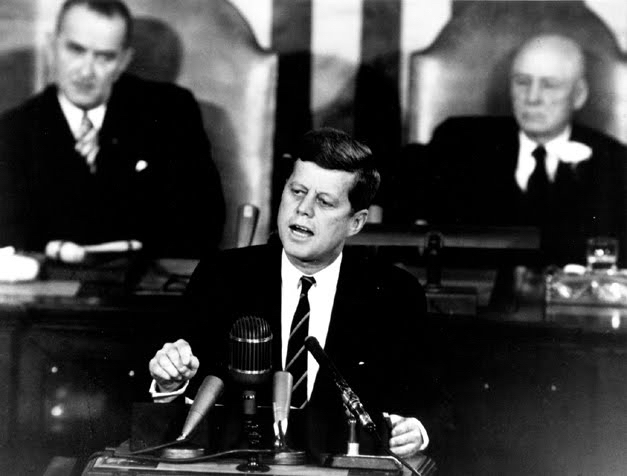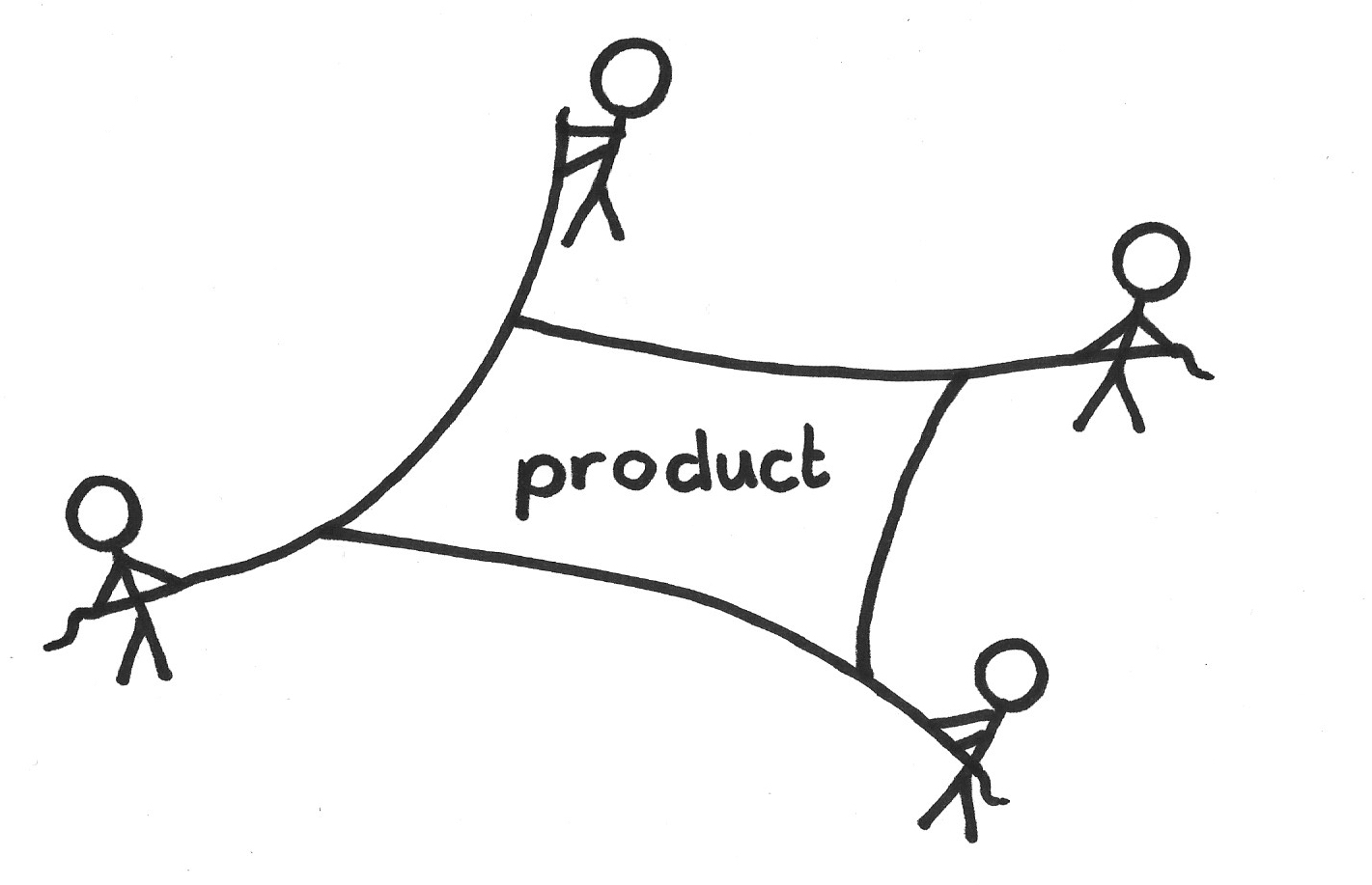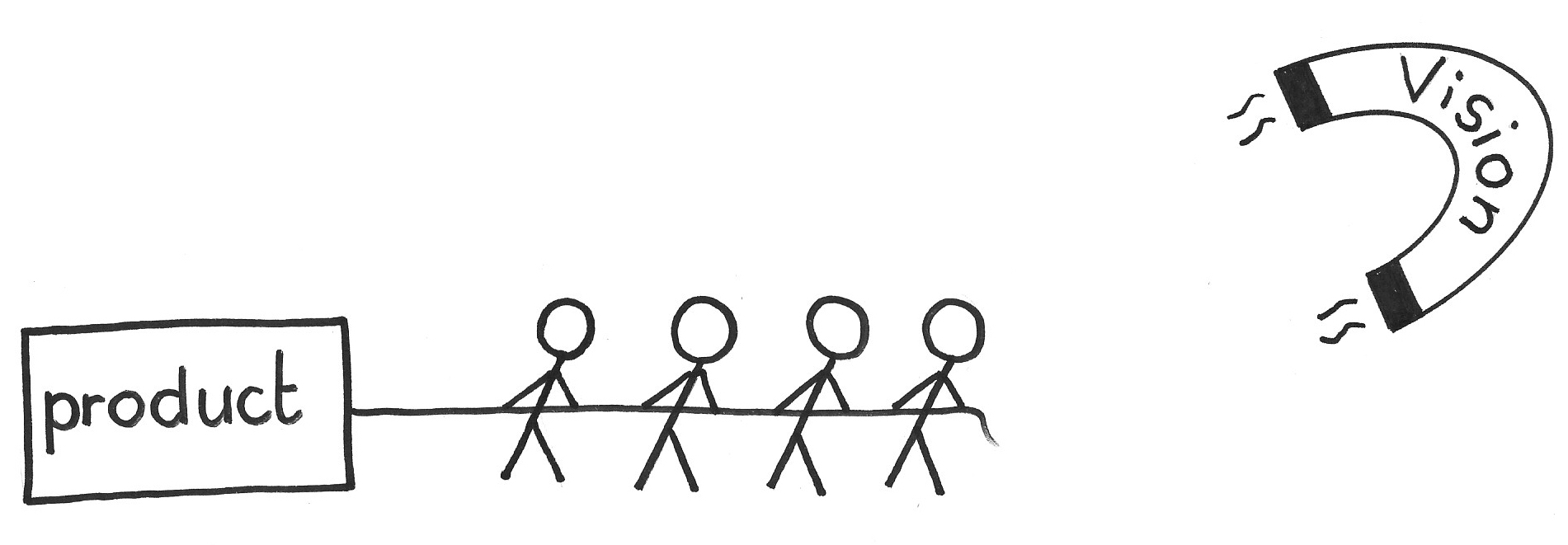Alias: Product Vision
...having come out of The Mist, some core visionary individual or group must make their passion concrete, in a conceptualization that can be shared, and excite a group of people to work as one mind to build something that will increase the quality of life for their constituency.
✥ ✥ ✥
People thrive within constraints that channel their creativity and work towards a common good, but it’s also true that overly specific constraints can turn contributors into subservient robots who blindly follow orders rather than following with their heart.
To achieve a great vision usually requires the work of an aligned team, as well as alignment between that team and its stakeholders. Teams comprise individuals with opinions and feelings, and though they all may be well-meaning, each may conceptualize and express their anticipated contributions in different ways. This creates the appearance of a conflict between team members. Yet if one strips off such noise that can dominate how team members view each other, one can usually tap into shared feelings and conceptualizations that draw deeply on the shared culture of the stakeholders.
This diversity in perspective within a team brings great value, because it raises the probability that the team will overlook no great idea. Admitting multiple perspectives and soliciting the input of people with different backgrounds and experiences helps the effort explore a wide variety of options. The different experiences and ideas open additional, innovative perspectives that can be valuable. Unchecked, these differences can fracture the team by taking the team in multiple directions.
For a team to be truly effective, all members need to be pulling in the same direction.
The team works in the direction of a shared goal. When the shared goal is too broadly defined or vague, the team risks exploring too many lower-value directions. The effort can lose energy and momentum in the false starts of unnecessary experimentation. If the shared goal is too narrow, it overly constrains the team and they may leave valuable directions unexplored—a waste of intellect and creativity.
A goal becomes shared when the team takes ownership of it. The team takes ownership of the goal when it co-creates it. It becomes their goal.
The future is inherently unknowable; committing to a final result or plan over a long time frame is fraught with danger. There are too many external forces to consider. Yet teams need a shared goal to create cohesion and direct performance.
Therefore:
The individual who embodies the passion for this new product effort takes on the role of Product Owner, around whom stakeholders and potential future coworkers rally to articulate and together to define and refine a Vision. The Vision is a description of how the product supports a desired future toward which an envisioned future Product Organization advances (as described in the Product Organization Pattern Language).
✥ ✥ ✥
We can think of the Vision as having two components. The first—which we just refer to just as the Vision—is a broad future direction, while the Product Vision breaks down that broad direction into more specific business components. The Vision provides a flexible, explicit rallying point to guide the emergent group forward as a team. It supports systems-thinking understanding of how the envisioned product effort will benefit their own lives and those of their end users and of other stakeholders. One key aspect of the Vision pertains to the product itself. The Product Vision goes beyond being a vague motherhood statement and is quite concrete. The Product Vision lies at the intersection of the passion behind the idea, the demand for the idea, and the feasibility of building something great. Typically, the Product Vision ([1], p. 24) covers these considerations:
- Key features of the product
- Who is going to use the product
- Customer needs the product will address
- How the vendor will benefit
The Product Owner owns the Vision and sets out to realize it by creating a Product Organization as well as by defining a Value Stream. The Product Owner articulates a path toward the Vision as a Product Roadmap, and works with stakeholders to reduce it to a concrete, specific Product Backlog. Each of these helps clarify the Vision, in varying forms and degrees, to the Product Organization and particularly to the Scrum Teams. The Vision gives everyone a greater sense of direction and collective purpose (see Unity of Purpose). The Product Organization and the teams can in turn vet deliverables in terms of their support for the Vision. Teams can measure their progress against bringing this Vision to reality.
Having an effective Vision can help set direction, help inspire and unify the Scrum Team, and help shape the behavior of the team without constraining its creativity. A great Vision is one that gets you out of bed in the morning and charges you up for the day. The Vision guides the creation and enactment of a Value Stream to realize the Vision and deliver a series of product increments to stakeholders.
Visions evolve over time, and some product efforts bring a quick discovery that the original Vision was off the mark, but the basic ideas can carry through to support what is sometimes an even grander Vision. Because we are agile, we can adjust our progress towards the Vision, or can even adjust the Vision itself over time.
Katsuaki Watanabe, then CEO of Toyota, believed in setting “impossible goals” as visions that drove Toyota’s strategic direction:
Many of Toyota’s goals are purposely vague, allowing employees to channel their energies in different directions and forcing specialists from different functions to collaborate across the rigid silos in which they usually work. For example, Watanabe has said that his goal is to build a car that makes the air cleaner, prevents accidents, makes people healthier and happier when they drive it, and gets you from coast to coast on one tank of gas ... [2]
At the end of the 1970s, Bill Gates and Paul Allen had a vision of “a computer on every desk and in every home.” The Vision became reality when “there was kind of a magical breakthrough when the computer became cheap, and we could see that everyone could afford a computer.” [3] Now in the twenty-first century, Elon Musk is working on his vision “to make humanity a multiplanet species.” [4] He has already taken successful steps in accomplishing his vision by making reusable rockets to lower the cost of launches. [5]
A great Vision aspires to some, perhaps transcendent, Greatest Value. For example, journalists in the Netherlands started a new chocolate company, Tony’s Chocolonely, out of a vision of creating chocolate bars made with slave-free labor. [6]
[1] Roman Pichler. Agile Product Management with Scrum: Creating Products That Customers Love, 1st ed. Reading, MA: Addison-Wesley Signature Series (Cohn), 2010, p. 24.
[2] Hirotaka Takeuchi, Emi Osono, and Norihiko Shimizu. “The Contradictions that Drive Toyota’s Success.” In Harvard Business Review 86(6), June 2008.
[3] Bill Gates. Interview. Academy of Achievement. http://www.achievement.org/autodoc/page/gat0int-1, 2010 (accessed 27 August 2016).
[4] Carl Hofman. “Elon Musk Is Betting His Fortune on a Mission Beyond Earth’s Orbit.” Wired.com, http://www.wired.com/2007/05/ff-space-musk, 22 May 2007 (accessed 27 August 2016).
[5] Julie Johnson and Dana Hull. “Musk’s SpaceX returns rocket for perfect upright landing.” In The Seattle Times, http://www.seattletimes.com/business/boeing-aerospace/musks-spacex-returns-rocket-for-perfect-upright-landing/, 22 December 2015 (accessed 27 August 2016).
[6] —. Tonys Chocolonely Annual Report. https://tonyschocolonely.com/storage/configurations/tonyschocolonelycom.app/files/jaarfairslag/2017-2017/tc_jaarfairslag_2016_en_totaal_01.pdf, 2017 (no longer accessible; accessed 6 June 2018).
Picture credits: Photo Credit: NASA, ID: 9260665, https://images.nasa.gov/details-9260665.html (Public domain).


